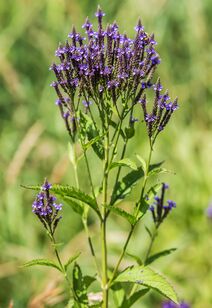Verbena hastata
| Verbena hastata | |
 | |
| Light: | |
| Moisture: | |
| Hardiness: | 3 |
| Soil pH: | 5.6-8.4 |
| Self Pollinated | |
| Height: | 5' |
| Width: | 2' |
| Blooms: | Mid Summer-Late Summer |
| Native to: | |
| Nectary | |
| Edible Rating: | |
| Medicinal Rating: | |
| Tea: | Yes |
Verbena hastata (common name: American blue vervain and blue vervain) is a forb with long-lasting candelabra-like flowers that attracts many bees and hummingbirds. The plant hosts Common Buckeye butterflies and feeds cardinals, sparrows, and juncos with its seeds. Mammals usually avoid the bitter greens, except for cottontail rabbits which feed on the young foliage. Thriving in wet soil, colonies can form from slowly spreading rhizomes and self-seeding. While scent-free, blue vervains make excellent companion plants alongside fragrant boneset and Joe Pye weed.
Propagation: Seed - sow early spring in a greenhouse or cold frame and only just cover the seed[1]. When they are large enough to handle, prick the seedlings out into individual pots and plant them out in the summer.
Division in spring. Larger divisions can be planted out direct into their permanent positions. We have found that it is best to pot up smaller divisions and grow them on in light shade in a greenhouse or cold frame until they are growing away well. Plant them out in the summer or the following spring.
Basal cuttings in early summer. Harvest the shoots with plenty of underground stem when they are about 8 - 10cm above the ground. Pot them up into individual pots and keep them in light shade in a cold frame or greenhouse until they are rooting well. Plant them out in the summer.
Cultivation: Succeeds in any moderately fertile well-drained but moisture retentive soil in a sunny position[1][2].
Plants are hardy to about -20°c[3].
Range: N. America - Nova Scotia and New Brunswick to Florida, and from California to British Columbia.
Habitat: Swales, damp thickets and shores[4].
Edibility: Seed - cooked[5]. The seed can be roasted and ground into a powder or used whole as a piñole[6][7][8][5]. Pleasantly bitter, some of this bitterness can be removed by leeching the flour[8].
The leaves are used as a tea substitute[7][8][5].
Medicinal: The leaves and roots are antiperiodic, diaphoretic, emetic, expectorant, tonic, vermifuge and vulnerary[9][10][11][12]. The roots are more active than the leaves[12]. The plant is used in the treatment of stomach aches, gravel, worms and scrofula[9][5]. An infusion of the roots, leaves or seeds has been used in the early stages of fevers[5].
A snuff made from the dried flowers has been used to treat nose bleeds[5].
Pollinators: Bees, flies, lepidoptera, self
Soil: Can grow in light, medium, and heavy soils.
Drainage: Prefers well drained soil.
Flower Type: Hermaphrodite
Links
- Verbena hastata - Plants for a Future
- Verbena hastata - USDA Plant Profile
References
- ↑ 1.0 1.1 Chittendon, Fred. RHS Dictionary of Plants. Oxford University Press, 1951.
- ↑ Huxley, Anthony. The New Royal Horticultural Society Dictionary of Gardening. MacMillan Press, 1992.
- ↑ Phillips, Roger and Martyn Rix. Perennials - The Definitve Reference. Pan Books, 1991.
- ↑ Lyndon, Merritt. Gray's Manual of Botany. American Book Co, 1950.
- ↑ 5.0 5.1 5.2 5.3 5.4 5.5 Moerman, Daniel. Native American Ethnobotany. Timber Press, 1998.
- ↑ Tanaka, Tyōzaburō. Tanaka's Cyclopaedia of Edible Plants of the World. Keigaku Publishing, 1976.
- ↑ 7.0 7.1 Yanovsky, Elias. Food Plants of the North American Indians Publication 237. US Department of Agriculture.
- ↑ 8.0 8.1 8.2 Facciola, Stephen. Cornucopia - A Source Book of Edible Plants. Kampong Publications, 1990.
- ↑ 9.0 9.1 Grieve, Margaret. A Modern Herbal. Penguin, 1984.
- ↑ Lust, John. The Herb Book. Bantam Books, 1983.
- ↑ Uphof, Johannes. Dictionary of Economic Plants. Weinheim, 1959.
- ↑ 12.0 12.1 Foster, Steven and Billy Tatum. Medicinal Plants of Eastern and Central North America. Houghton Mifflin, 1990.